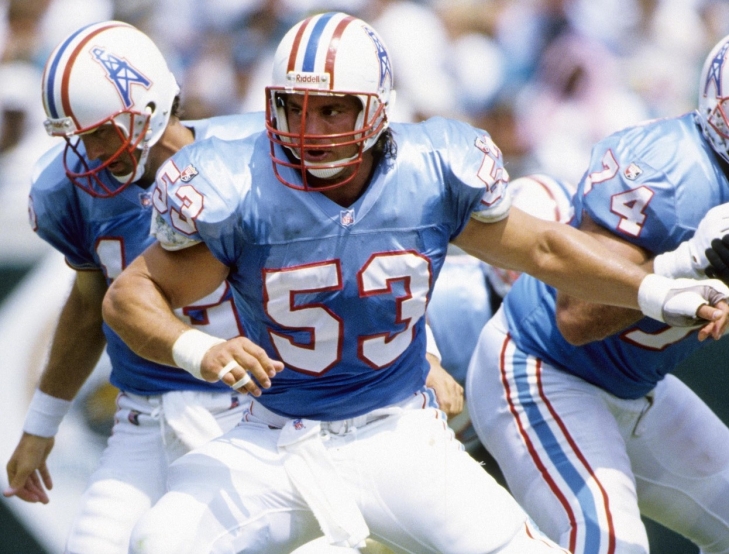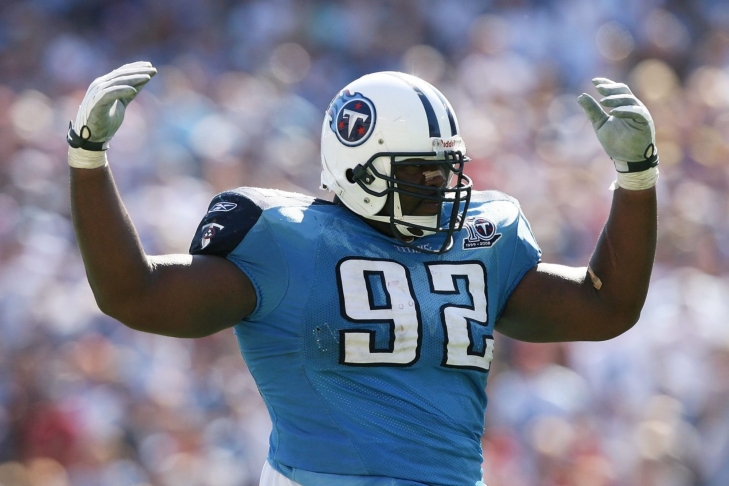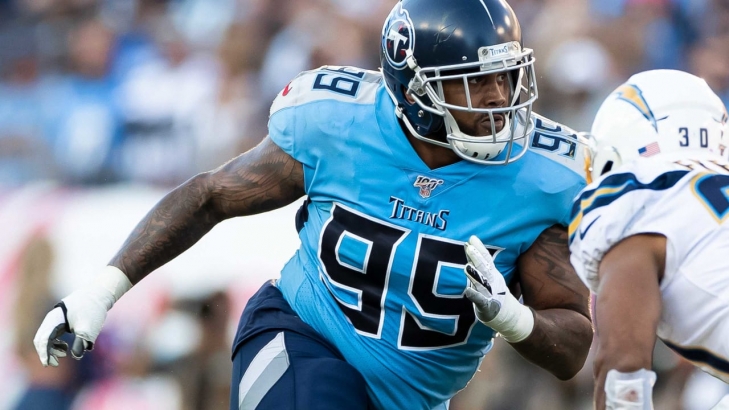36. Al Jamison
There are a lot of “What ifs?” in sports, but in terms of the Houston Oilers/Tennessee Titans, Al Jamison might have been the first but still the most appropriate.
Undrafted out of Colgate, "The Assassin," as he was known for his punishing play, signed with the Oilers, winning the starting Left Tackle job as a rookie. Jamison was phenomenal, earning First Team All-Pro honors while helping Houston win the inaugural AFL Title. The Oilers won it again in 1961, with Jamison even better, securing a second First Team All-Pro nod. This was the last title for Houston in the AFL, but not the last First Team All-Pro for Jamison, as he did it again in his third year.
A severe back problem rendered 1962 his last season, and he never played football again, thus ending what began as a Hall of Fame worthy career.
50. Mark Stepnoski
After six years with the Dallas Cowboys, Mark Stepnoski joined the Houston Oilers. Notably, the Center brought a three-year streak of Pro Bowls with him, and he continued that in Houston, earning that accolade in 1995 and 1996, giving him five in total.
As the team relocated to Tennessee, Stepnoski’s Pro Bowl days were behind him, but Stepnoski was still a top Center. He played two more years for the now-named Titans and would rejoin the Cowboys for the 2000 Season.
Stepnoski started all 61 of his Games for Houston/Tennessee.
35. Miller Farr
The first two years of Miller Farr's pro career could only be classified as "O.K.," as the Defensive Back from Wichita State was not a head-turner in his time with Denver and San Diego. Farr joined the Oilers in 1967, and for a three-year period, he was one of the best Corners in the AFL.
Farr exploded with an AFL-leading 10 Interceptions and 264 Interception Return Yards. He was rewarded with a First Team All-Pro Selection, and he was so again in 1968, though Farr was not going to sneak up on anyone anymore and was rarely targeted by opposing Quarterbacks. Farr was stellar again in 1969, collecting a third straight AFL All-Star nod.
He would bolt for the St. Louis Cardinals after, but he was never the same player again that he was with Houston. Farr amassed 19 Interceptions with the Oilers, an excellent number for only three years of service.
34. George Webster
George Webster was a beast at Michigan State, earning two All-Americans and a trip to the College Football Hall of Fame. The Houston Oilers grabbed him Fifth Overall in the first ever Common Draft between the AFL and NFL, and for the first three seasons, he was incredible as a pro.
In the aforementioned time frame, Webster was named a First Team All-Pro and an AFL-All Star. Webster, who UPI named the Rookie of the Year (1967), controlled the middle of the field expertly and was go good in those three seasons, that he was named to the AFL All-Time Team.
After 1969, a barrage of injuries beset Webster, and he was never close to being the same player. His role diminished, as did his health, and he was released during the 1972 Season.
Webster's peak pro period was brief but was impactful.
33. Albert Haynesworth
There is a lot to unpack with Albert Haynesworth, but for a two-year period, he was in the conversation as the best defensive player in football.
Haynesworth's ascendence to the upper rung of Defensive Tackles seemingly came out of nowhere despite being a First Round Pick (2002). Haynesworth only started five Games as a rookie, and while he became a starter as a sophomore, he was not considered one of the top players at his position, nor would he be until 2007, though the year before he became infamous when he stomped on the face of Dallas’ Center, Andre Gurode.
Haynesworth’s game shot up in 2007, where he put up then career-highs in Sacks (8.5) and had 12 Tackles for Loss. His skill caught up with his ferocity, and he had an even better 2008, where he had 8.5 Sacks, 51 Combined Tackles, and 15 Tackles for Loss. Haynesworth was a First Team All-Pro both of those seasons, was the runner-up in 2007 for the Defensive Player of the Year, and was fourth in 2008. It was Haynesworth’s last year as a Titan, and as it would turn out, his last good year in football.
Haynesworth signed with the Washington Redskins as a Free Agent, and he was out of the game three years later. He might have been a controversial figure at one time, but his peak period in Tennessee has few equals.
49. Al Del Greco
From Auburn, Al Del Greco had a mediocre start in the NFL, four years with Green Bay, and four more with the St. Louis/Phoenix Cardinals. When he joined Houston (eventually Tennessee) in 1991, Del Greco was thought of more as a band-aid. As it turned out, he became "Automatic Al."
Del Greco never made the Pro Bowl, but there were seasons where he belonged in the conversation. With the Oilers/Titans, Del Greco never had a season where his Field Goal Percentage went below 76%, and he was in the top ten five times. Del Greco led the NFL in Field Goals Made in 1998 (36) and was in the top ten six other years.
A member of the AFC Championship Team that made it to the Super Bowl (Del Greco made his lone FG attempt), he is currently the all-time franchise leader in Field Goals (246), Extra Points (322) and Points Scored (1,060).
27. Frank Wycheck
A bust in his first two NFL seasons with Washington, Frank Wycheck signed with the Houston Oilers in 1995, who would soon relocate to Tennessee and become the Titans. It was in the Volunteer State that Wychek would find his groove.
Wychek’s first two years as an Oiler/Titan was good, but his offensive production jumped in 1997, where he began a five-year streak of at least 600 Receiving Yards. A Pro Bowl Selection from 1998 to 2000, Wychek was instrumental in one of the most famous plays in franchise history, "The Music City Miracle." In the 2000 AFC Wild Card Game, the Titans were down 16-15, with 16 seconds left. Wycheck took the handoff from Lorenzo Neal and then passed it to Kevin Dyson, who ran 75 Yards for the winning Touchdown. The play is disputed to this day as to whether it was a backward or forward pass. The Titans made it to the Super Bowl that year, albeit in a losing effort.
Wycheck was extremely popular in Tennessee, and he finished his career for the team, retiring in 2003. With the Titans, Wycheck accumulated 4,958 Yards with 27 Touchdowns. The franchise inducted him to their Hall of Fame in 2008.
31. Kyle Vanden Bosch
Kyle Vanden Bosch began his career with the Arizona Cardinals, serving four years there, but he is arguably best known for missing one complete season due to an ACL injury. Vanden Bosch joined Tennessee in 2005, and the change of scenery proved beneficial for the Defensive End.
Vanden Bocsh played five years for the Titans, and in alternating years (2005, 2007 & 2009) was a Pro Bowl Selection. Vanden Bosch showed off a nice blend of pass-rushing and run-stuffing in this five-year run, twice having a 12-Sack year and becoming a fan favorite.
He joined Detroit in 2010 and would have 270 Combined Tackles with 38.5 Sacks as a Titan.
30 Haywood Jeffires
Haywood Jeffires was a First Round Pick (20th Overall in 1987), but injuries and the depth chart held him to only nine Games with 138 Yards in his first two seasons. That changed in his third year.
The Wide Receiver from North Carolina State had 47 Receptions with 619 Yards that year, and he became a top target for Warren Moon afterward, hitting at least 1,000 Yards the next two seasons. In 1991, Jeffires led the NFL in Receptions (100) and was a First Team All-Pro with a Pro Bowl Selection. He would go to the Pro Bowl the next two years, remaining a top wide out for the Oilers, completing seven straight years with at least 600 Yards.
Jeffires signed with New Orleans in 1996 but only played one more year before he retired. With the Oilers, Jeffires totaled 6,119 Yards with 47 Touchdowns.
29. Brad Hopkins
A First Round Pick from Illinois, Brad Hopkins was an All-Rookie for the Oilers in 1993 at Left Tackle. This would be his role for the franchise for the next 12 years.
Hopkins played his entire career with the Oilers/Titans, starting 188 of his 194 Games. Twice named to the Pro Bowl (2000 & 2003), Hopkins was a dependable presence on the left side of the line, allowing the organization to worry about holes elsewhere for a decade-plus.
It is grunt work but necessary.
26. Blaine Bishop
From Ball State, Blaine Bishop landed a job with the Houston Oilers, who took the Defensive Back with their Eighth Round Pick. He made the team as a rookie but would win a starter's role in his second season.
As Houston’s starting Strong Safety, Bishop went to his first of three Pro Bowls in 1995, with the streak continuing as the team moved to Tennessee. Bishop secured the fourth one in 2000 and played with the Titans until 2001, accumulating 738 Tackles for the team.
25. Derrick Mason
Derrick Mason did not play much in his first three seasons after Tennessee took him in the Fourth Round in the ’97 Draft, but he became a starter in 2000, and it initiated a long and consistent run as a close-to-the-top tier Wide Receiver.
Mason was a First Team All-Pro as a Returner, leading the NFL in Punt Return Yards (662), with another 1,132 Yards from Kick Returns. Mason also had 895 Yards from the air, totaling 2,690 All-Purpose Yards, again leading the NFL. He returned less in the following years, as Titans used him more on offense. Mason became a top option, exceeding 1,000 Receiving Yards over the next four seasons and earning a Pro Bowl trip in 2003.
Mason bolted for the Ravens after that year, but with the Titans, he produced 11,202 All-Purpose Yards.
24. Drew Hill
Drew Hill played his first six seasons (one on the injured list) for the Los Angeles Rams, but they were nothing special, and none of which saw him crack 20 Receptions. This changed when he joined the Oilers in 1985.
At age 28, Hill had his first four-digit Receiving Yard season (1,168). It would be easy to see this is a fluke, but Hill proved to be a worthy staring Wide Receiver, cracking 1,000 Yards four more times and becoming the first man to break that mark four times after 30. Hill was a two-time Pro Bowl Selection (1988 & 1990) and amassed 7,477 Yards for Houston, a number that nobody would have projected when he joined the team.
23. Ken Burrough
Ken Burrough was a First Round Pick in 1970, chosen 10th Overall by New Orleans. Burrough had a lousy rookie year, oft-injured and only recording 13 Receptions. The Saints decided to trade him to Houston, and while he didn’t do much as an NFL sophomore, the rest of the decade would become more productive.
Burrough became a regular starter in 1972, and in 1975, he caught 53 passes for a league-leading 1,063 Yards. For his efforts, he went to his first Pro Bowl and was a Second Team All-Pro. This would be Burrough's peak year, but he still eclipsed over 800 Yards the next two years and was a Pro Bowler again in 1977. After two more good years, injuries took him out of most of 1980, though he rebounded for one final year, a 668 Yard and 7 TD campaign.
He had 6,906 Yards with 47 Touchdowns as an Oiler.
Jurrell Casey Retires
A week before the 2021 NFL Season is to begin, we now know that five-time Pro Bowl Defensive Lineman, Jurrell Casey, will not be among the players. Casey, 31, retired today, after a ten-year career.
Playing his college ball at USC, Casey arrived in the NFL to Tennessee as a Third Round Pick in 2011. Casey became an immediate starter at Right Defensive Tackle, and was arguably robbed of a Pro Bowl in 2013, a year he had a career-high 10.5 Sacks. He would finally get that first Pro Bowl in 2015, which would lead to four more in succession.
A Titan for all but his final year in football, Casey had 51.0 Sacks, all in Tennessee, and was a large part of the Titans defensive turnaround in the 2010s.
Casey, was also known for his philanthropy, and was the winner of two community service awards.
In our most recent updated list of active players based on Hall of Fame potential, Casey was ranked at #80. He will be eligible for the Pro Football Hall of Fame in 2026.
We here at Notinhalloffame.com would like to wish Casey the best in his post-playing career.
9. Derrick Henry
Derrick Henry was a power Running Back at Alabama, where as a junior, he won the Heisman and led the Crimson Tide to a National Championship. Despite this, there were concerned that his playing style would not be conducive to a long NFL career, and it dropped him to the Second Round, where the Titans took him.
Henry backed up DeMarco Murray as a rookie and sophomore, accumulating over 1,100 Rushing Yards over those two campaigns. He took over as the lead Back in 2019, rushing for 1,059 Yards with 12 Touchdowns, but it was the springboard for what was to come.
Henry won the Rushing Title in 2019 (1,540) with what also a league-leading 16 Rushing Touchdowns. This was not a fluke, as he joined the exclusive 2,000-Yard club (2,027) and breaking his previous record with 17 TDs on the ground. Henry was named the AP Offensive Player of the Year, an appropriate honor for the Titan's workhorse. Had Henry not got injured during the 2021 Season, it is possible that a second Rushing Title and OPOY occured. The year after, Henry was again one of the beasts on the ground, rushing for 1,538 Yards and 13 Touchdowns while adding a third Pro Bowl. Henry played one more season with the Titans where he rushed for 1,167 Yards and went to his fourth Pro Bowl.
The Baltimore Ravens signed Henry afterward, and he left the team with 9,502 Rushing Yards and 90 Touchdowns.
22. Jevon Kearse
Very few people had a rookie season like Jevon Kearse.
A First Rounder from Florida where he won the Bowl Alliance National Championship and was an SEC Defensive Player of the Year, Kearse was a beast as a rookie, winning the AP Defensive Rookie of the Year, and was also the AFC Defensive Player of the Year. The Defensive End led the NFL in Forced Fumbles (8) and recorded 14.5 Sacks and 15 Tackles for Loss. The sky appeared to be the limit for Kearse, but that wasn't to be.
Kearse, who was a First Team All-Pro as a rookie, was never an All=Pro again, though he was a Pro Bowler in his first three seasons, where he had double-digits in Sacks in all three years. His production did negatively slide in those three years, and it fell when injuries took him out of 12 Games in 2002. After a respectable 2003, Kearse left Tennessee for Philadelphia, but he would never come close to what he accomplished as a rookie.
Kearse returned to Tennessee in 2008, where he played two more seasons before retiring. He would have 52 of his 74 Sacks as a Titan.
21. Ernest Givins
Ernest Givins was one of the best returners in the history of Louisville and was also a star Wide Receiver. The Houston Oilers used their Second Round Pick to obtain him, and he would become one of the best Wide Receivers in history.
Givins had 1,062 Receiving Yards as a rookie, which was his career-high. That isn't to say that he considerably regressed, as, over the next five seasons, he had at least 900 Yards in four of them. A crowd favorite for his electric slide touchdown dance, Givins went to the Pro Bowl in both 1990 and 1992, where he had nine and ten Touchdowns. He played with the Titans until 1994 and had one final year with Jacksonville.
As a Titan, Givins had 7,935 Yards with 46 Touchdowns.
20. Keith Bulluck
A star at Syracuse, Keith Bulluck was a late First Round Pick in 2000, where he was chosen by the Titans, who had big plans for the young Linebacker.
Bulluck played primarily off of the bench in his first two years and would win the starting job at Right Linebacker in 2002. He would regularly be among the league's top tacklers, amassing at least 127 Combined Tackles five years in a row from 2002 to 2006, and was the NFL leader in 2004 with 152. Bulluck, who was a First Team All-Pro and Pro Bowler in 2003, would come close to joining the 20-20 club with 19 Interceptions and 18 Sacks as a Titan.
He left Tennessee in 2009, playing one final campaign in the NFL with the New York Giants.
19. Tony Banfield
A product of Oklahoma State, Tony Banfield signed with the Houston Oilers of the American Football League, an easy decision as he was not drafted by any team in the NFL. Banfield would win the starting job at Left Cornerback as a rookie, and he helped the Oilers win the inaugural AFL Championship.
Following that success, Banfield went on a three-year tear as one of the top Defensive Backs in the AFL. The Oilers successfully defended their title in 1961, and Banfield was a First Team All-Pro and AFL All-Star that year and the two after.
He would, unfortunately, have knee problems that forced him out of the entire 1964 Season, and he was mediocre when he was back in 1965. Banfield retired afterward but still had 27 Interceptions over his brief career and was one of the franchise's first defensive stars.





















